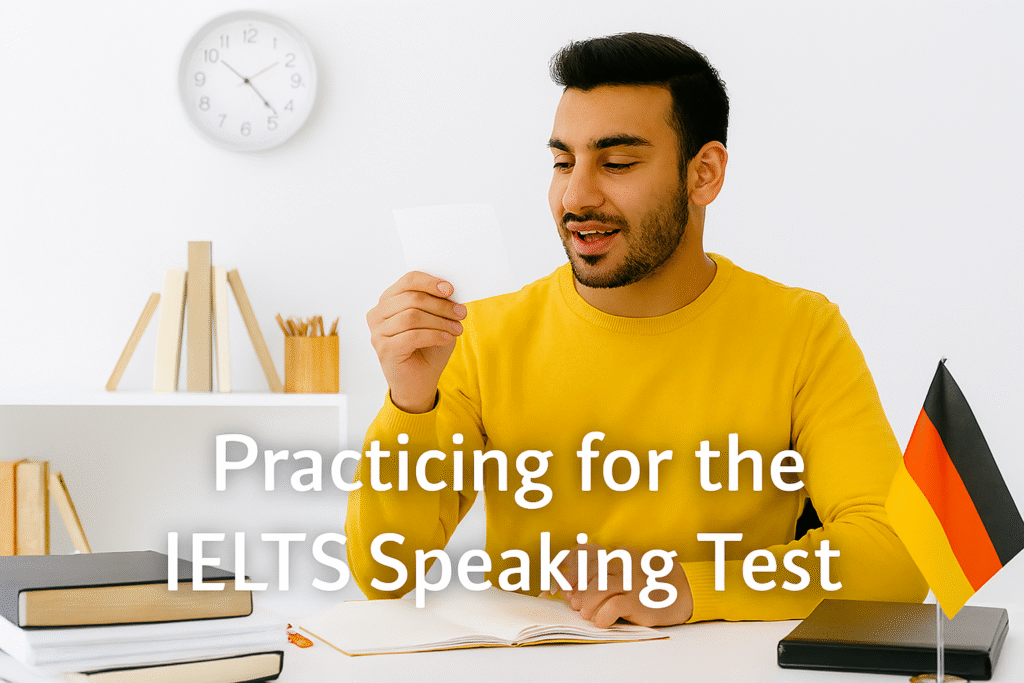
What is IELTS Speaking Cue Cards? Cue cards are Speaking test instrument in IELTS Speaking part 2. In this part the examiner gives you a topic card with some bullet points. You will have one minute to prepare and then you will need to speak for 1–2 minutes on the topic. For a lot of students that’s daunting because they have to think fast, organize their ideas and speak fluently without too many pauses.
Learning strategies on how to deal with cue cards not only builds confidence, it also enhances your ability to speak in general. You can learn to reduce hesitation and articulate clearly.
What is the importance of Fluency in the Speaking Test?
Fluency is one of the four key factors considered when calculating your speaking band scores. It measures how well you can flow with your thoughts without having too many gaps, fillers, or repetition. Strong fluency can aid you even if your grammar isn’t very good, so you can get a good score.
Several learners get trains to focus on fluency and coherence as one of the best ielts coaching in chandigarh. This is communicating in a natural flow and linking your ideas in a logical manner.
Tips to Make Cue Cards
1. Practice with Real Classic Topics
Gathering historic IELTS cue card subjects from official materials and utilizing them frequently This assists you familiarize yourself with the questions and vocabulary which they ask and use For instance: subjects can be about describe memorable trip you took, a book you enjoyed reading, or a decision you made.
2. Use Your One-Minute Preparation Time Wisely
Use the 1 minute preparation time with the exam card in your hand to jot down a few notes When you receive the card from the examiner, take that one minute to write down a few key
words on the card. Write down simple points like “where, when, who, feeling” not
complete sentences. “It provides you a guided tour when you speak,” Brown added.
3. Distinct ideas clearly stated and sequenced
- Try to organize your response in three sections:
- Intro: Explain very shortly what you will mention.
- Main Body: Address to the issues in the card with some examples.
- End: Present a brief opinion or thought.
This format enables you to limit off-topic talk and organise your discussion.
Language and Vocabulary Tips
Connectors for fluency in writing
Words such as “firstly,” “in addition,” “on the other hand” and “finally” are some connectives needed to be used to link sentences. They help make your response sound more natural and fluent.
Develop Ideas with Examples
Instead of answering shortly elaborate your points with brief details. For instance, rather than “I liked the trip” you can say, “I liked the trip because it allowed me to spend time with my cousins and taste local food.”
Don’t Have Long Waits in Between Speak
You can say something like “well,” “let me think,” “actually”. But be mindful not to use them too frequently. Short fillers are natural but long silence can lower your band scores.
Buzz of Practice Strand of Fluency
- Regular practice speaking is how you gain fluency. You should:
- While practising cue cards record your voice.
- Listen and check when you stop or repeat yourself.
- Speak to friends or study group.
- Participate in mock speaking test at training centre.
Lots of students who study with best ielts coaching in chandigarh have observed that they become far more fluent once they start practicing daily with cue cards.
Connection With Cue Cards and Writing
Cue cards do relate to writing skills Speaking About the Cue Cards They are really a’)
On practicing cue cards you get to know how to organize thoughts on the fly and getting them across in speak clearly This is a useful skill to have for IELTS writing task 2 as well where you need to write your ideas out in an IntroductionBodyC#UdE of your essay.
For instance for Writing Task 2 you might have to write about the advantages and disadvantages of technology. Depending on the task, the cue cards Can also help you generate certain points for essays. You Need to have Clear Ideas, Examples Well Defined And Natural in Both Speaking and Writing.
Controlling Your Nerves During The Speaking Test
Some test takers get anxious when they are asked by the examiner to speak for two minutes. In the meantime, to manage this:
- Breathe deeply before you begin.
- Ideas not grammar errors.
- Look at the examiner and make a conversation.
- Smile to relax yourself.
Confidence makes a big difference in fluency.
Training at Home
You Can still practice cue cards even if you don’t have a speaking partner. Pick some random topic, get ready for one minute, and record your answer. Then listen carefully to see if you:
- Spoke continuously for two minutes.
- Repeated words too often.
- Used linking words correctly.
Doing this daily for a few weeks can make you more confident.


